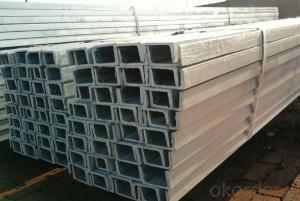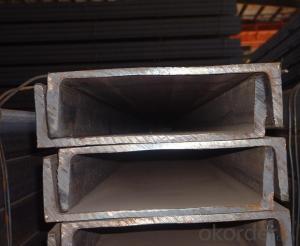Hot rolled high quality JIS U CHANNEL SS400
- Loading Port:
- Qingdao
- Payment Terms:
- TT OR LC
- Min Order Qty:
- 25 m.t.
- Supply Capability:
- 100000 m.t./month
OKorder Service Pledge
OKorder Financial Service
You Might Also Like
channel Details:
| Minimum Order Quantity: | Unit: | m.t. | Loading Port: | ||
| Supply Ability: | Payment Terms: | Package: | wire rod bundle |
Product Description:
Product Description:
Specifications of MS Channel:
1.We supply high quality MS Channel at reasonable price, including Chinese standard, Japanese standard and so on.
Standard | GB/JIS |
Material Grade | Q235,SS400 |
Technique: | Hot Rolled |
Sizes as per chinese standard: | 50*37*4.5mm - 300*89*11.5mm |
Sizes as per japanese standard: | 50*25*3mm – 200*80*7.5mm |
Length: | 6meter, 9meter, 12meter |
Note: 1.we are also competent to provide our customers other MS Channel based on other sizes according to customer’s requirements.
2. The length of our ms channel could be cut into other meters as per customer’s requirements. For example, the channel in 6meters could be cut into 5.8meters in order to be fit in the 20ft container.
2. The detailed sections of MS Channel as per GB standard.are shown in the table-1:
GB U CHANNEL | Standard | Sectional | Dimension |
| Mass: |
(mm) | (mm) | (mm) | (mm) | ||
50X37 | 50 | 37 | 4.50 | 7.0 | 5.438 |
63X40 | 63 | 40 | 4.80 | 7.5 | 6.634 |
80x43 | 80 | 43 | 5.00 | 8.0 | 8.045 |
100x48 | 100 | 48 | 5.30 | 8.5 | 10.007 |
120x53 | 120 | 53 | 5.50 | 9.0 | 12.059 |
140x58 | 140 | 58 | 6.00 | 9.5 | 14.535 |
140x60 | 140 | 60 | 8.00 | 9.5 | 16.733 |
160x63 | 160 | 63 | 6.50 | 10.0 | 17.240 |
160x65 | 160 | 65 | 8.50 | 10.0 | 19.752 |
180x68 | 180 | 68 | 7.00 | 10.5 | 20.174 |
180x70 | 180 | 70 | 9.00 | 10.5 | 23.000 |
200x73 | 200 | 73 | 7.00 | 11.0 | 22.637 |
200x75 | 200 | 75 | 9.00 | 11.0 | 25.777 |
220x77 | 220 | 77 | 7.00 | 11.5 | 24.999 |
220x79 | 220 | 79 | 9.00 | 11.5 | 28.453 |
250x78 | 250 | 78 | 7.00 | 12.0 | 27.410 |
250x80 | 250 | 80 | 9.00 | 12.0 | 31.335 |
250x82 | 250 | 82 | 11.00 | 12.0 | 35.260 |
280x82 | 280 | 82 | 7.50 | 12.5 | 31.427 |
280x84 | 280 | 84 | 9.50 | 12.5 | 35.823 |
280x86 | 280 | 86 | 11.50 | 12.5 | 40.219 |
300x85 | 300 | 85 | 7.50 | 13.5 | 34.463 |
300x87 | 300 | 87 | 9.50 | 13.5 | 39.173 |
300x89 | 300 | 89 | 11.50 | 13.5 | 43.883 |
Table-1
3. The chemical composition of HR Channel Steel according to Q235B is shown in Table-2.
Alloy No | Grade | Element(%) | ||||
C | Mn | S | P | Si | ||
Q235 | B | 0.12-0.20 | 0.3-0.7 | ≦0.045 | ≦0.045 | ≦0.3 |
Table-2
Note: we are able to present our customers relevant SGS test report for chemical composition of HR Channel Steel.
4. The mechanical property of HR Channel Steel according to Q235B is shown in Table-3-1 and Table-3-2
Alloy No | Grade | Yielding Strength Point(Mpa) | |||
Thickness(mm) | |||||
≦16 | >16-40 | >40-60 | >60-100 | ||
≧ | |||||
Q235 | B | 235 | 225 | 215 | 205 |
Table-3-1
Alloy No | Grade | Tensile Strength(Mpa) | Elongation After Fracture(%) | |||
Thickness(mm) | ||||||
≦16 | >16-40 | >40-60 | >60-100 | |||
≧ | ||||||
G235 | B | 375-500 | 26 | 25 | 24 | 23 |
Table-3-2
Note: we are able to present our customers relevant SGS test report for mechanical property of MS Channel as customer’s request.
Applications of MS Channel:
The MS Channel can be applied to construction of warehouses, workshops, sport stadiums and car parks etc.The hot rolled channel steel belongs to carbon structural steel which is applied to in the field of construction and machinery.In details, the hot rolled channel steel is usually used for arch-itechtural structure, and they could be welded in order to support or hang a vari-ety of facilities. They are also usually used in combination with I beam. Generally,the hot rolled channel steel we supply must possess perfect welding property, riveting property and mechanical property and so on.
Package & Delivery of MS Channel:
1.The hot rolled channel steel will be packed in bundle with steel wire at each end of every bundle and color marking in order to help the customer to recognize his goods more easily at sight.
2. And the hot rolled channel steel could be loaded into 20ft or 40ft container, or by bulk cargo.If the weight of each bundle reaches more than 3.5 mt, the loading by break bulk cargo should be choosed.When the weight of each bundle reaches less than 3mt, the loading by container should be choosed.
3.As for the transportaion from mill to loading port, the truck will be usually used. And the maximum quantity for each truck is 40mt.
4.All in all, we could do in accordance with customer's request
- Q: Are steel channels suitable for use in HVAC systems?
- Yes, steel channels are suitable for use in HVAC systems. Steel channels are commonly used in HVAC systems for various applications such as ductwork, support structures, and equipment mounting. Steel channels offer excellent strength and durability, making them capable of withstanding the rigorous demands of HVAC systems. They can effectively support the weight of ducts, equipment, and other components, ensuring the stability and integrity of the system. Additionally, steel channels provide a reliable and secure method for routing and organizing HVAC components, allowing for efficient and effective airflow. They are also resistant to corrosion and can withstand high temperatures, making them suitable for use in various environments and conditions. Overall, steel channels are a reliable and practical choice for HVAC systems, offering the necessary strength, durability, and functionality required for optimal performance.
- Q: Which kind of wind resistance is better for square tube, square tube or channel steel?
- Square pipe and channel steel that load-bearing better 1, the same thickness and area, square superior to channel. 2, if the channel is closed to a rectangular tube, then the channel is better than the square tube.
- Q: What angles, angles and channels are used in general? Please try to be specificWhat are the shapes used in construction?
- Many, steel column, steel beam, steel roof truss, curtain wall steel skeleton, billboard skeleton, special door....
- Q: Can steel channels be powder-coated?
- Yes, steel channels can be powder-coated. Powder coating is a popular finishing technique used to apply a durable and protective layer of color to various metal surfaces, including steel channels. The process involves applying a dry powder onto the steel channel and then heating it to create a smooth and even coating. This coating not only enhances the appearance of the steel channel but also provides additional protection against corrosion, UV rays, and general wear and tear. Powder coating is an environmentally friendly and cost-effective solution for steel channels, making them more resistant to scratches, chipping, and fading.
- Q: Is it OK to use the channel steel to do the Overhanging Scaffold? Is there any difference between the cantilever scaffold made of I-beam and channel steel?
- Personally think that as long as the channel can withstand the weight of scaffolding on the line, but also consider the case of falling things momentum
- Q: No. 20 I-beam span 3 meters, fixed on both sides, what is the maximum weight to bear? No. 10 channel steel, span 2.5 meters, the other ibid
- I-beam is also called steel girder (English name Universal Beam). It is a strip of steel with an I-shaped section. I-beam is divided into ordinary I-beam and light I-beam, H steel three. It is a section steel whose shape is trough.
- Q: What are the corrosion resistance properties of steel channels?
- Steel channels have excellent corrosion resistance properties due to the protective oxide layer that forms on their surface, which acts as a barrier against moisture, chemicals, and other corrosive substances. Additionally, their high strength and durability contribute to their ability to withstand corrosion over long periods of time.
- Q: Can steel channels be used in rooftop installations?
- Yes, steel channels can be used in rooftop installations. Steel channels are commonly used for structural support in various construction applications, including rooftop installations. They provide strength and stability to the structure, making them suitable for holding heavy loads and withstanding external forces. Additionally, steel channels are durable and resistant to corrosion, making them a reliable choice for rooftop installations that are exposed to weather conditions.
- Q: What are the different shapes available in steel channels?
- Steel channels come in various shapes, each designed for specific purposes and applications. Some commonly used shapes include: 1. Structural applications often utilize the C-channel, which resembles the letter "C". It offers excellent strength and stability, making it suitable for supporting heavy loads. 2. The U-channel, shaped like the letter "U", is commonly used in framing, construction, and manufacturing industries. It provides good resistance against bending and serves as a base for mounted equipment or a support for structural frameworks. 3. Also known as a furring channel, the Hat channel gets its name from its resemblance to a hat. It is frequently used in construction to provide a framework for attaching ceiling tiles or supporting drywall or plasterboard. In roofing applications, it provides extra support. 4. The Box channel, resembling a box or rectangle, is widely used in manufacturing and construction industries for applications requiring high strength and rigidity. It is commonly used for framing, bracing, and supporting heavy loads. 5. The Z-channel, shaped like the letter "Z", is often used to join two pieces of material together, such as panels or sheets. It adds strength and stability to the joint and finds application in the manufacturing of cabinets, enclosures, and shelving systems. These examples represent only a fraction of the available steel channel shapes. The choice of shape depends on specific project requirements, including load-bearing capacity, structural integrity, and the intended application.
- Q: Could you tell me the theoretical weight and size of 16 and 18 channel steel?
- 14 # A 140×58×6.0 14.53514 # 140×60×8.0 16.733 B16 # a 160×63×6.5 17.2416 # B 160×65×8.5 19.75218 # a 180×68×7.0 20.174# 180×70×18 B 9 2320 # a 200×73×7.0 22.63720 # B 200×75×9.0 25.777
Send your message to us
Hot rolled high quality JIS U CHANNEL SS400
- Loading Port:
- Qingdao
- Payment Terms:
- TT OR LC
- Min Order Qty:
- 25 m.t.
- Supply Capability:
- 100000 m.t./month
OKorder Service Pledge
OKorder Financial Service
Similar products
Hot products
Hot Searches
Related keywords




























